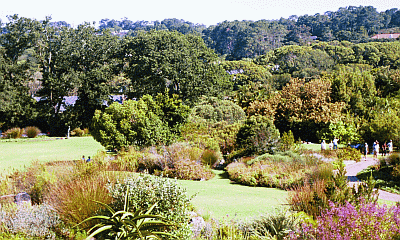

Kirstenbosch Gardens is a must see when visiting Cape Town
Kirstenbosch Botanical Gardens is well known around the world for the diversity of indigenous plants cultivated there and the scenic mountain setting. It has done wonders for South Africa tourism and is considered an ideal family vacation destination. Kirstenbosch Gardens officially extend across an area of 528 hectares along the eastern slopes of Table Mountain (the mountain table) from Cecelia Forest to Newlands Forest. The landscaped and developed section has increased in size over the years to 36 hectares, and there is also a nature reserve. Maintenance work at Kirstenbosch Gardens has been made easier by the use of modern technology and machines, and the Gardens have been laid out to facilitate visitor access and enjoyment.
If you're a lover of indigenous plants you'll find plenty here. Half of South Africa's species of flowering plants are cultivated, including about 9000 varieties of indigenous plants unique to the Cape South Africa - locally known as Cape 'fynbos'. There are also many specimens of rare and endangered plants on display. The commander of the Dutch East India Company, Jan van Riebeeck, appointed a forester in the area in 1657 to supply timber to the Company. Muscat Grapevines were planted at Kirstenbosch in 1659. In the 1660s an almond hedge was planted by shipwrecked French refugees, to form a boundary for the Dutch settlement - and probably to prevent theft of their cattle. Sections of this hedge are still visible today in the Gardens. Van Riebeeck owned a farm in the area called Boschheuwel. He planted various fruit trees, oaks and fields of wheat. The origin of the name Kirstenbosch is thought to have been taken from the name of the manager of the land, J.F.Kirsten, in the 1700s. Return from this Kirstenbosch Gardens page to Home page |
Must See Pages
on this site


How to build income with SBI!















































